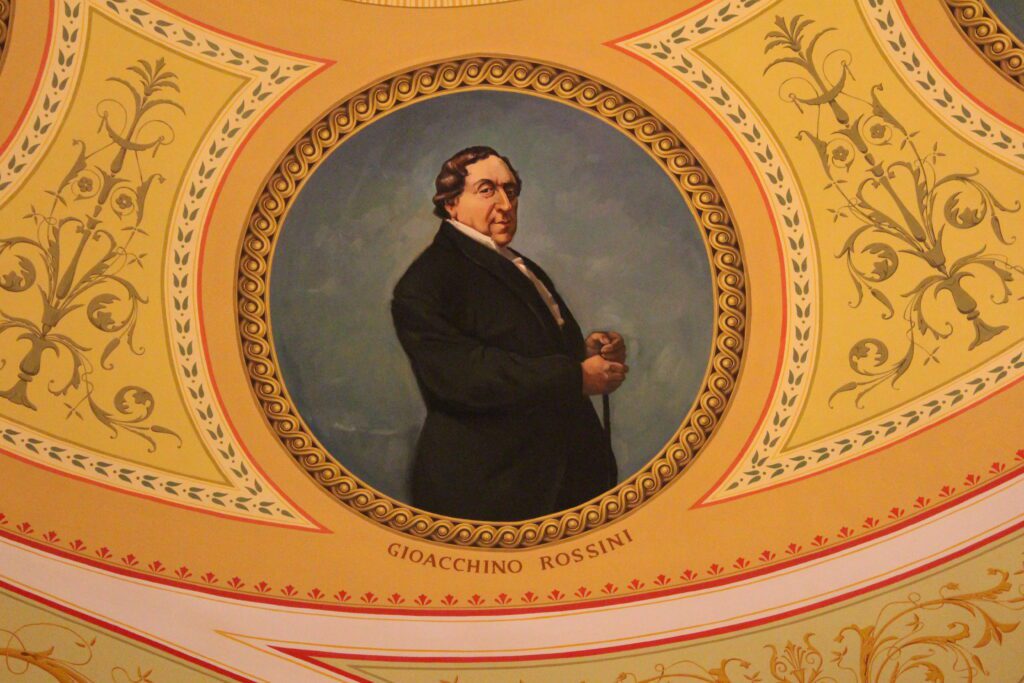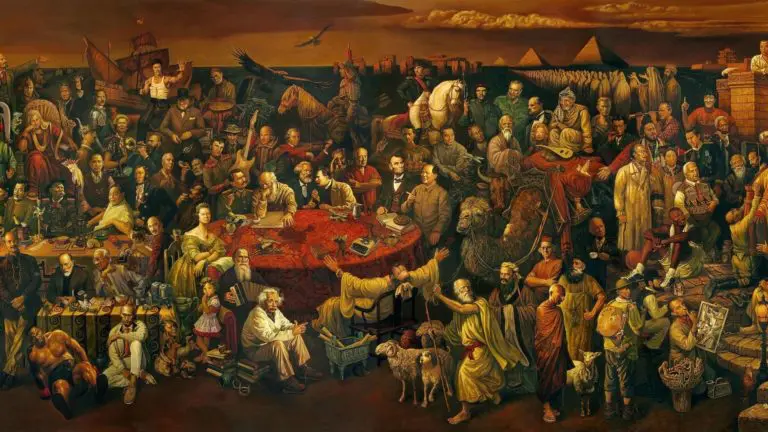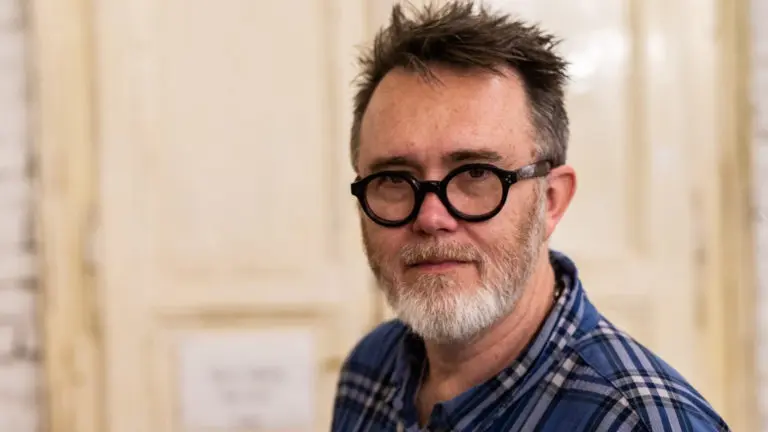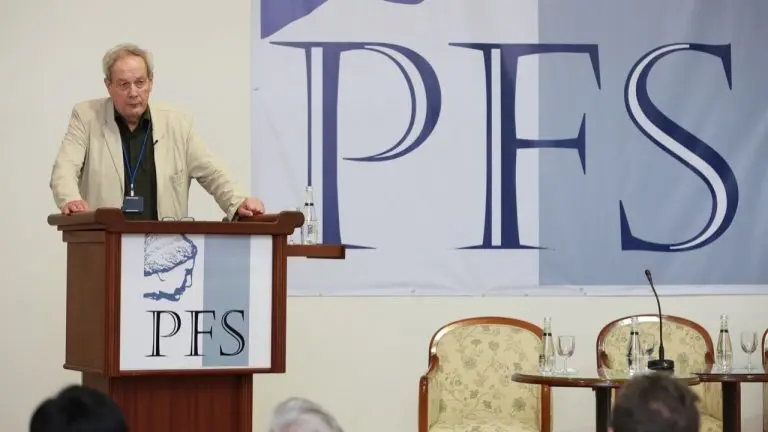Rossini has a way of rehearsing that is entirely his own. He does not make a single movement, hardly says two or three words and relies completely on [his conductor and répétiteur Giuseppe] Festa. His guiding principle is not to irritate the orchestra and, above all, not to humiliate the musicians. His prodigious memory allows him to communicate his observations to everyone separately after the rehearsal. On leaving the Teatro di San Carlo, I accompanied him to the copyist to whom he pointed out about 50 mistakes without glancing at the score. The more you experience this man up close, the more you think of him as a superior being.
(Anonymous report of February 15, 1822, on the general rehearsal of Rossini’s opera Zelmira, published in the Journal des débats politiques et littéraires of Monday, March 11, 1822.)
Already during his lifetime, Gioachino Rossini (1792-1868) was regularly confronted with the prejudice that he was solely destined to delight the world with comic operas. In the spring of 1822, Rossini was in Vienna, where he made every effort to meet Ludwig van Beethoven, whom he deeply admired. That meeting went rather disappointingly, partly as a result of Beethoven’s deafness. What may also not have been conducive to the atmosphere is the fact that although the German master called Rossini’s Il barbiere di Siviglia “an excellent comic opera,” he felt compelled to add that Rossini should confine himself exclusively to the comic opera genre. Should Rossini move into other areas, he would only oppose what fate had ordained for him, according to Beethoven. That must have been a rather shocking statement in the eyes of Rossini, who already had numerous successful serious operas such as Otello, Mosè in Egitto, and La donna del lago to his name.
In fairness, we must acknowledge that Rossini himself sometimes seemed to agree with Beethoven. Didn’t he write in his preface to his Petite messe solennelle, addressed to God himself, that he was “born for the opera buffa”? Yet the facts speak for themselves: in Rossini’s Neapolitan period (1815-1823), the emphasis was overwhelmingly on serious opera rather than on the lighter genre of comic opera. Moreover, Philip Gossett, the great connoisseur of Rossini’s oeuvre, rightly observes: “Not only did Rossini compose some of his finest operas for Naples, but these operas profoundly affected operatic composition in Italy and made possible the developments that were to lead to Verdi.” I completely agree with Gossett. Hence, I have decided to delve deeper here into the still far too unknown ‘melodramma’ La donna del lago rather than the much more frequently performed Barbiere.

The impresario Domenico Barbaia (1778-1841) was playing high stakes when, in 1815, he entrusted the musical management of Naples’ two main theatres, the Teatro di San Carlo and the Teatro del Fondo, to the 23-year-old Gioachino Rossini. Not only had the young master from Pesaro been educated in Bologna, but his field of activity had previously been limited to northern Italy, and these factors alone were enough reason for the chauvinistic Neapolitans to consider Rossini’s arrival an open declaration of war.
It was therefore clear to Rossini that he would have to break the atmosphere of resistance with a great coup de théâtre. He achieved this by playing all the trump cards the theatre offered him in his first opera for the Teatro di San Carlo—the serious opera Elisabetta, regina d’Inghilterra. The theatre had an excellent orchestra consisting of no less than 80 or so permanent members—a huge number for the time, especially in Italy. The choir had around 30 members, which was also large for an Italian theatre of the time and inspired Rossini to write choral scenes of unprecedented power. Last but not least, Rossini had at his disposal an exquisite ‘compagnia’ (‘troupe’) of singers contracted by Barbaia. The core of the troupe was formed by the Spanish soprano Isabella Colbran and the tenor Andrea Nozzari, who sang in all of the nine serious operas Rossini composed for the local theatres in his Neapolitan period between 1815 and 1822. In 1822, with her voice showing increasingly obvious signs of wear and tear, Colbran would marry Rossini.
In La donna del lago (1819), the seventh serious opera Rossini wrote for Naples, all the aforementioned characteristics of Elisabetta recur in intensified form. Even more clearly than Elisabetta, La donna del lago reflects the extraordinary wealth of sometimes contradictory tendencies that characterised Italian culture around 1820. Put simply, in this period, ‘northern’ romanticism and ‘southern’ classicism competed for primacy in Italian opera. This struggle reveals itself on many different levels (text, music, costumes, and sets) in Rossini’s serious operas.
The libretto of La donna del lago is based on Sir Walter Scott’s early romantic poem The Lady of the Lake, published in 1810. The librettist, Andrea Leone Tottola (ca. 1780-1831), who worked after a French translation of Scott’s poem, does not adhere strictly to the example but also responds to the Ossian craze that had gripped the whole of Europe for more than half a century: the references to the ‘Sons of Morven’ (‘Figli di Morven’) and the legendary Celtic hero Tremmor do not appear in Scott’s work, but were immediately comprehensible to the audiences of the time. Since the Scottish theologian-teacher James Macpherson published three collections of supposed translations of the mythical Gaelic bard Ossian in the years 1760-1763, sensitive souls all over Europe revelled in the intense sentiments of heroism and loneliness of Nordic heroes.

No matter how much success Rossini had with most of his operas, he regularly allowed himself certain liberties with the declamation, with the result that word accents and musical accents sometimes do not coincide naturally and are even at odds with each other. This met with sometimes fierce criticism from connoisseurs (letterati). In his defence, Rossini argued that any real music is based on “simple melody and clear rhythm” (“melodia semplice e ritmo chiaro”). According to Rossini, music should aspire to an abstract beauty (“bello ideale”), which has little to do with imitation of natural sounds or even of spoken language. For Rossini, the starting point was that the theatre has its own laws, in which only “the logic of the heart” (“la logica del cuore”) rules supreme. Hence, he never condemned the increasingly criticised phenomenon of the castrato singer as a “sin against nature.” On the contrary, only a few years before his death, Rossini wrote: “These mutilated singers … were the founders of the singing that is felt in the depths of the soul [“il cantar che nell’anima si sente”] and the terrible decline of the Italian bel canto had its origin in their disappearance.”
The last castrato for whom Rossini composed was Giovanni Battista Velluti (1781-1861), who sang the role of Arbace in Aureliano in Palmira in Milan in 1813. When Rossini came to Naples in 1815, he had to make do without castrati there. From then on, he preferred to have the role of the young, passionate lover performed by an alto “en travesty” (“contralto musico”), an alto dressed as a man. As the Teatro di San Carlo did not initially dispose of an alto, Rossini pressured Barbaia to recruit one in the person of Rosmunda Pisaroni. For her, Rossini wrote the role of Elena’s lover Malcom (sic!) in La donna del lago, the most richly decorated and graceful part of this opera. With her warm, deep sound, she must have formed a fine contrast to the brilliant voice of Isabella Colbran, who took on the role of Elena. The tenor Nozzari, who played the role of the resistance hero Rodrigo, also got a worthy counterpart in the lighter and higher tenor Giovanni David, who, as King Giacomo V, finally subdues the rebellious Highlanders. Both tenors are asked several times to sing a high c′′—David even has to master a high d′′—but neither of them sang such high notes with the full chest voice that will later in time become common among ‘romantic’ tenors, but with the lighter falsetto technique, which meant that colour and agility did not fall prey to sheer volume and power.
Looking at the score, the first thing that catches the eye is the colourful instrumentation: the orchestra consists of 2 ottavini (piccolos), 2 flutes, 2 oboes, 2 clarinets, 2 bassoons, 4 horns, 2 trumpets, 3 trombones, percussion, harp, and strings in the pit, supplemented by 6 horns and a wind ensemble (‘banda’) on stage. It is mainly the way Rossini manages to exploit the muffled colours of the horns, clarinet, and harp that sometimes results in an early romantic sound world. Neapolitan audiences were at first baffled by the opera when it premiered on October 24, 1819, but finally gave in at the revival a year later. A fun fact: La donna del lago is not entirely by the master himself. The recitatives are almost all the work of an anonymous collaborator, who also signed for the only aria by Elena’s tyrannical father, Duglas (bass). The great time pressure under which Rossini had to work would have been partly to blame. Anyway, La donna del lago was among Rossini’s most popular works for almost half a century, only to disappear almost completely from view until the 1980s. The Netherlands was reacquainted with Rossini’s compelling score on March 28, 1992, when La donna del lago was performed with great success in the ZaterdagMatinee series in the Concertgebouw.
After La donna del lago, Rossini would add a dozen more operas to his oeuvre in a decade. Among them are some of Rossini’s most impressive masterpieces, as the performance of Semiramide in the Matinee series of February 1, 2020, for instance, proved conclusively. With his French-language Grand opéra Guillaume Tell (1829), Rossini bid a final farewell to the opera theatre at the age of 37 and at the height of his fame. He did write, however, a moving Stabat mater in 1832 (revised and completed in 1841) and the aforementioned Mass, a grand work, to which he gave with characteristic irony the misleading title of Petite messe solennelle (1864).
There has been endless speculation about the reasons for Rossini’s ‘abdication.’ It is well known that Rossini had increasing difficulties with the direction in which the art of singing was developing; not for nothing did he speak disparagingly of the “barking” that passed for singing (“canto abbaiato”). Or was it his manic-depressive disposition that was the deciding factor? Did the fact that he had already earned a huge amount of money play a role? Probably a combination of all these factors.
What is certain, as far as I am concerned, is that the ‘serious’ Rossini still does not get the appreciation he deserves in the opera world. He may partly be responsible for this himself: with his salient anecdotes, eternal jokes, mysterious silence, and notorious penchant for culinary delights, he has led many people astray, consciously or unconsciously. Moreover, Rossini’s incredibly high technical demands in many of his opera roles result in the fact that truly convincing performances, especially in serious operas, are still quite rare. An impressive opera like Ermione, after its (unsuccessful) premiere in 1819, had to wait until 1987 for its first scenic performance in modern times.
Even in the particular case of Ermione, Rossini himself was partly to blame. When asked if he would allow a new performance in French translation, he replied that the work had been rightly forgotten, as the opera would consist only of recitative and declamation! The reprise of Ermione in Pesaro in 1987 proved the composer wrong: the score overflows with beautiful melodies. Nevertheless, the performance in Pesaro was a dramatic failure, despite the participation of great singers such as Marilyn Horne, Rockwell Blake, and Chris Merritt. There were several reasons for this: Montserrat Caballé was in the aftermath of her glorious career and audibly struggled with the title role; the conductor arrived totally unprepared; the direction was dull and uninspired. Fortunately, the opera’s quality was nevertheless recognised by many, and revivals soon followed in Rome (1991), Glyndebourne (1995), and Santa Fe (2000).
Recommended recordings
A very convincing live recording of La donna del lago, made in Edinburgh on August 18, 2006, has appeared on Opera Rara Classics. Conductor Maurizio Benini strikes just the right tone for this serious opera by Rossini, somewhere in the middle between classicist clarity and early romantic sensibility. Not long ago, Glossa released the sparkling live recording of L’italiana in Algeri conducted by Giancarlo Andretta at the ZaterdagMatinee series on February 19, 2022. The unforgettable Stabat mater exists in a whole range of good but often very heavy and monumental performances. I very much like the transparent interpretation, with a choir that is not too large and an orchestra playing on instruments from Rossini’s time, conducted by the British conductor Marcus Creed (harmonia mundi). Of the Petite messe solennelle (in the original version for four soloists, choir, two pianos, and harmonium), the recent recording with the Coro Ghislieri conducted by Giulio Prandi is highly recommended (Arcana).






